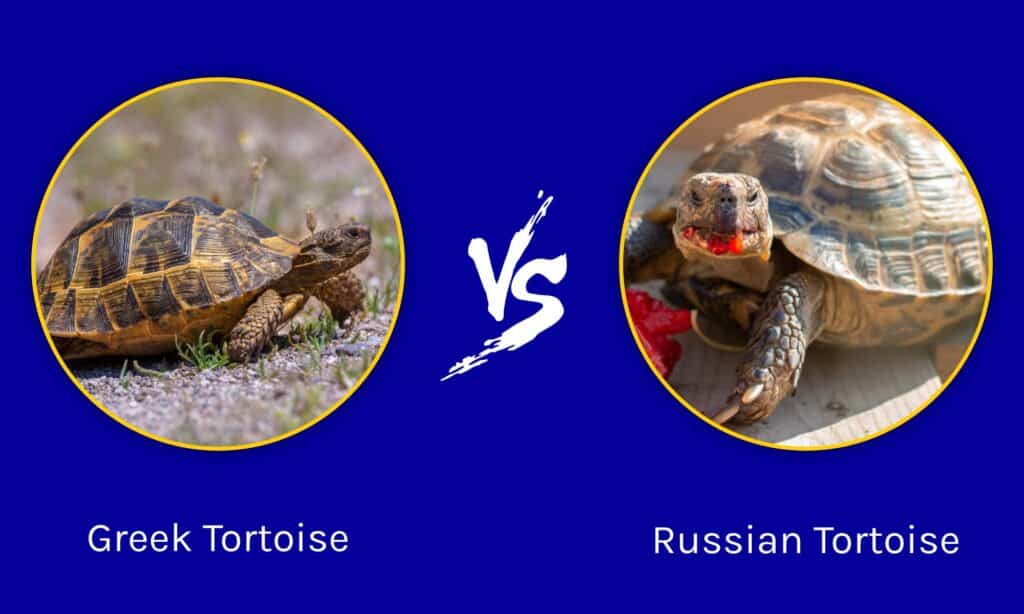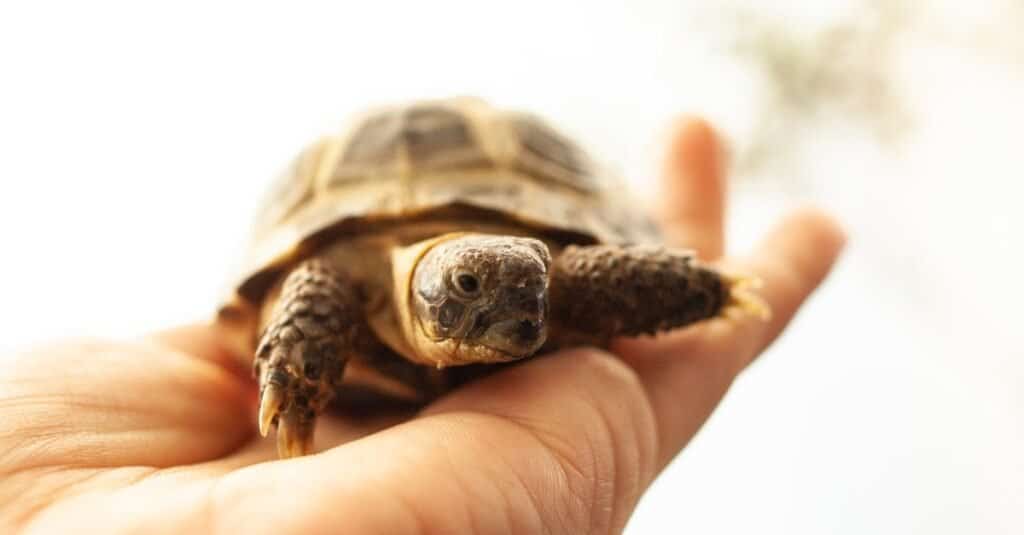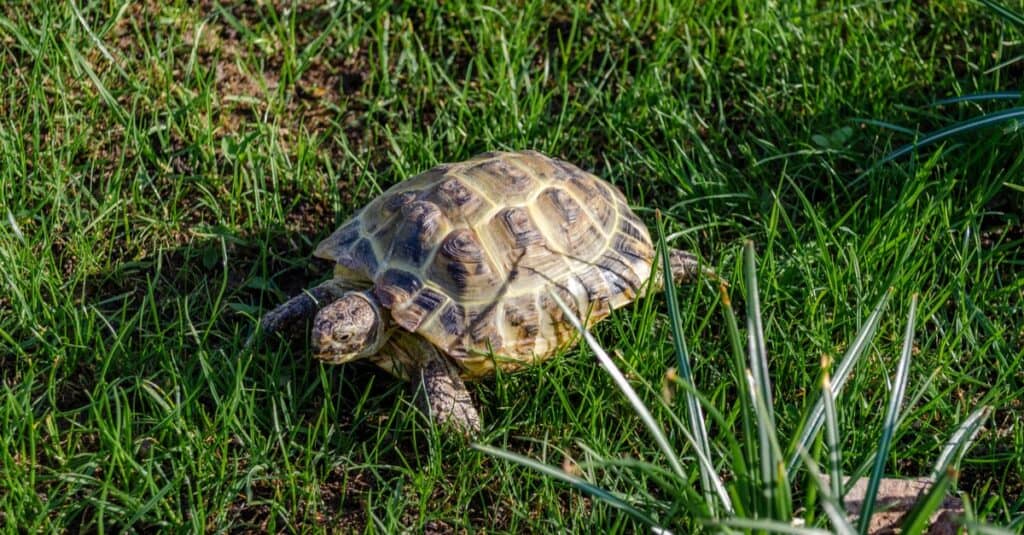There are so many different types of pets that people can get. Although some people may think that only dogs and cats can have meaningful relationships with their humans, this is far from being the case.
In fact, a tortoise can actually have a big personality and be very responsive to you. You can get very attached to a tortoise and love him or her just like any other pet.
If you’re thinking about what kind of tortoise to get, you may want to learn more about different types. For example, we’re about to go into detail about the differences between Greek tortoise vs Russian tortoise.
Comparing Greek Tortoise vs Russian Tortoise

| Greek Tortoise | Russian Tortoise | |
|---|---|---|
| Size | 6 to 7 inches long | Males are 5 to 8 inches long, females are 6 to 10 inches long |
| Personality | Generally active in the daytime, comfortable in their environments, and good at burrowing and climbing. | Generally active in the daytime, good at burrowing and climbing, comfortable in their environments. Somewhat shy in unfamiliar environments. |
| Appearance | Domed carapace, concave plastron in the male. Relatively narrow and oval-shaped. | Flat carapace and plastron. Somewhat of a round shape, and a hard tail tip. Unique feature of four claws on each foot. |
| Diet | Herbivorous diet; they should be fed mostly grass and vegetables, including dark leafy greens. Vitamin and calcium supplements are necessary, particularly for young tortoises. Fruit should make up no more than 10% of the diet. Should always have access to a shallow dish of water for hydration. | Herbivorous diet; should be eating mostly grass and vegetables, such as dark leafy greens. Can also eat bell peppers, hay, squash, and carrots. Always need access to a shallow dish of water to stay hydrated. |
| Required Conditions | Should have spacious enclosures, but do not put them in glass tanks outside. Need 12 to 14 hours of UVB light every day. When they are basking, the temperature should be 95°, although it can go down to 65° to 75° at night. Humidity should not go under 50%. | Should have spacious enclosures, but do not put them in glass tanks outside. Need 12 to 14 hours of UVB light every day. When they are basking, the temperature should be 95° to 100°, with a minimum of 80°. Humidity should stay around 60%. |
| Care | Need regular warm water baths to get rid of waste. The enclosure and water dish should be cleaned regularly, and the tortoise should be checked to make sure it is healthy regularly. | Need regular warm water baths to get rid of waste. Baby tortoises need to be soaked in water as well, to avoid dehydration. Water dish and enclosure should be cleaned regularly. Tortoise should be checked for good health regularly. Be aware that these tortoises are prone to suffering from gastrointestinal parasites and respiratory tract infections under certain conditions. |
| Lifespan | Over 50 years with proper care | Over 40 years with proper care |
Greek Tortoise vs Russian Tortoise: Key Differences
There are many similarities between the Greek and Russian tortoises. They both require UVB light every day, although their temperature requirements are slightly different. They have somewhat different requirements when it comes to bedding, as the Russian tortoise is more likely to burrow into the ground.
The Russian tortoise also needs slightly more humidity than the Greek tortoise in his or her environment. Both the Greek and Russian tortoise require a specific type of environment, with the right bedding.
Greek tortoises also have a somewhat more restricted diet than Russian tortoises. Both species are fairly active during the day and good at burrowing and climbing, although the Russian tortoise is more likely to be reserved in unfamiliar environments.
The Greek tortoise is also slightly smaller and has a slightly longer lifespan when compared to the Russian tortoise.
Still interested in learning more about what sets these tortoises apart from one another? Let’s dive in!
Greek Tortoise vs Russian Tortoise: Size

The Russian tortoise is larger than the Greek tortoise on average.
©Elena M. Tarasova/Shutterstock.com
On average, the Russian tortoise is larger than the Greek tortoise. The length range for a Russian tortoise is about 5 to 10 inches long, with the males being closer to 5 to 8 inches and the females tending to be 6 to 10 inches. An adult Greek tortoise is usually 6 to 7 inches long.
Greek Tortoise vs Russian Tortoise: Personality
[Image here of Greek tortoise | Caption: Greek and Russian tortoises are both active in the daytime and good at climbing and burrowing, but Russian tortoises are more likely to be shy in new environments.]
Both of these tortoises are generally active in the daytime. They are good at climbing and burrowing. If they are in the correct environment, they will be comfortable. Generally, they are not aggressive to one another, unless it’s mating season.
The main difference between the Greek tortoise and Russian tortoise in terms of personality is that the Russian tortoise is more likely to be shy in unfamiliar environments.
Greek Tortoise vs Russian Tortoise: Appearance

Greek tortoises have domed carapaces, while Russian tortoises have flat ones; Russian tortoises also have hard tail tips and four claws on each foot.
©KOTORICHIKAPHOTO/Shutterstock.com
The most significant difference in the appearance of these two tortoises involves the carapace, or the top part of the tortoise shell. The Russian tortoise has a flat carapace, while the Greek tortoise has a domed one. Russian tortoises are generally somewhat round, while Greek tortoises are more narrow and oval-shaped.
There are also differences in the plastron, or the bottom shell. Male and female Russian tortoises have flat plastrons, while the male Greek tortoise has a concave plastron.
The Russian tortoise has a hard, bony tip of the tail that is longer in the male tortoise. Greek tortoises do not have this hard tip.
The Russian tortoise has the unique feature of having four claws on each foot – other tortoise species do not have this.
Greek Tortoise vs Russian Tortoise: Diet
[Image here of Greek tortoise | Caption: Greek and Russian tortoises are both herbivores, but the diet of the Greek tortoise is somewhat more restrictive.]
Both of these tortoises are herbivores. You should feed your Greek tortoise a diet primarily composed of grass and vegetables. They can eat many dark leafy greens, such as zucchini, spinach, mustard greens, collards, and kale.
Young and baby tortoises need vitamin and calcium supplements on a daily basis, and adults need these once or twice a week. Fruits can be a maximum of 10% of what they eat, as excessive amounts of sugar in fruit will give your tortoise diarrhea.
The Russian tortoise has a wider repertoire of food that they can eat, also including carrots, bell peppers, squash, and hay. You should not be feeding either tortoise iceberg lettuce, which lacks nutrition. Avoid feeding them meat and grains as well.
It’s important that a shallow dish of water always be in your tortoise’s living space, so that he or she can stay hydrated.
Greek Tortoise vs Russian Tortoise: Required Conditions

Greek and Russian tortoises both need space and UVB light, but Russian tortoises thrive in higher temperatures.
©Elena M. Tarasova/Shutterstock.com
When it is warm outside, it’s ideal to have these tortoises outside with spacious enclosures. Make sure that they aren’t able to dig their way out, as tortoises are often known to do this. The walls should be between 6 and 12 inches tall.
It’s important that you never house either of these tortoises in glass tanks outside, as this will create too hot of an environment in the enclosure and kill the animal. If you have the tortoise housed indoors, you should have him or her in a 40-gallon terrarium or a large plastic enclosure.
Light, Temperature, and Humidity
If housing is indoors, either tortoise will need about 12 to 14 hours of UVB light. This is necessary, as it provides the vitamin D3 that the tortoise needs for healthy growth.
For the Greek tortoise, a temperature of about 95° Fahrenheit should be consistent in the basking areas; they can fall to 65 to 75° at night. For the Russian tortoise, a temperature of between 95° and 100° should be maintained in the basking area, with a low of 80°.
The Russian tortoise needs an environment with about 60% humidity in its housing, while the Greek tortoise just needs the humidity to not fall under 50%.
Bedding Materials
The Greek tortoise would do well with bedding made of play sand, topsoil, mulch, and aspen shavings. Don’t use pine or cedar bedding, as this will be toxic to the animal. The Russian tortoise is known to be a burrower, so it will need a deep layer of bedding. The best materials would be shredded aspen, cypress mulch, reptile bark, and clean soil.
Greek Tortoise vs Russian Tortoise: Care
[Image here of Greek tortoise | Caption: Greek and Russian tortoises both need warm water baths and regular cleanings of their surroundings; Russian tortoises are somewhat more prone to suffering from gastrointestinal parasites and respiratory tract infections.]
Either tortoise will need a warm water bath once or twice a week to get rid of waste. The water level should be in the middle, between the top and bottom of the shell. Check to make sure that the tortoise’s eyes are clear, that the shell and skin are in good condition, and that the animal seems active and alert. Make sure that you clean the enclosure and water dish regularly.
Baby Russian tortoises are prone to dehydration at high temperatures, and they should be soaked three times a week in a shallow container of warm water.
Russian tortoises can suffer from gastrointestinal parasites. They also often develop respiratory tract infections if they are not fed properly or they are staying in conditions that are too damn or cool. Juvenile tortoises that don’t have enough calcium or UV light are prone to development of metabolic bone disease.
Check your tortoise on a regular basis, regardless of its species. If you see any signs that the tortoise is unwell, take him or her to the vet immediately.
Greek Tortoise vs Russian Tortoise: Lifespan

The Greek tortoise has a longer lifespan than the Russian tortoise, assuming both were kept in good condition.
©Alexandra Kovaleva/Shutterstock.com
The Greek tortoise has a somewhat longer lifespan than the Russian tortoise. The Greek tortoise can live to be more than 50 years old, while the Russian tortoise can live to be more than 40. Of course, this is assuming that the tortoises have proper care and good environments.
The photo featured at the top of this post is ©
Thank you for reading! Have some feedback for us? Contact the AZ Animals editorial team.






